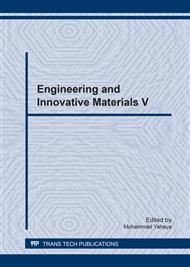p.3
p.9
p.14
p.19
p.25
p.30
p.36
p.45
Composite Material Modeling under Drop Weight Impact Test Using Finite Element Analysis
Abstract:
Composite material referred to build speed boats with a lightweight and also endured to support a crushing load. To design and analyze speed boats to support a collision accident, the composite material would be implemented into finite element model. This research had proposed the material model of a fiberglass composite material which used to construct speed boats in Pattaya, Thailand. The rectangular plate of composite material was analyzed according to the drop weight impact test. The orthotropic and isotropic material models were applied to define material properties of the finite element model of the fiberglass plate. The finite element analysis (FEA) results were compared with experimental data. The FEA with isotropic material for modeling the fiberglass material results were in good agreement with experiment. There was an average difference of 0.4195 J when compared the residual energy with the experimental data. Consequently, this fiberglass material model would be used to analyze the speed boat collision in a further work.
Info:
Periodical:
Pages:
3-8
Citation:
Online since:
March 2017
Authors:
Keywords:
Price:
Сopyright:
© 2017 Trans Tech Publications Ltd. All Rights Reserved
Share:
Citation:


